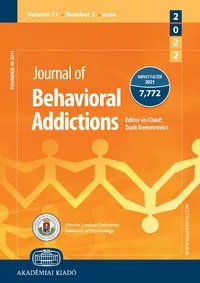An empirical investigation of the Pathways Model of problem gambling through the conjoint use of self-reports and behavioural tasks
An empirical investigation of the Pathways Model of problem gambling through the conjoint use of self-reports and behavioural tasks
Author(s): Céline Bonnaire, Gaëtan Devos, Servane Barrault, Marie Grall-Bronnec, Olivier Luminet, Joël BillieuxSubject(s): Behaviorism
Published by: Akadémiai Kiadó
Keywords: gambling disorder; impulsivity; emotion regulation; emotion reactivity; alexithymia; decision-making
Summary/Abstract: Background and aims. Blaszczynski and Nower (2002) conceptualized their Pathways Model by postulating the existence of three subtypes of problem gamblers who share common characteristics, but also present specific ones. Methods. This study investigated how the psychological mechanisms postulated in the Pathways Model predict clinical status in a sample that combined treatment-seeking gamblers (n = 59) and non-problematic community gamblers (n = 107). To test the Pathways Model, we computed a hierarchic logistic regression in which variables associated with each postulated pathway were entered sequentially to predict the status of the treatment-seeking gambler. Self-report questionnaires measured gambling-related cognitions, alexithymia, emotional reactivity, emotion regulation strategies and impulsivity. Behavioural tasks measured gambling persistence (slot machine task), decision-making under uncertainty (Iowa Gambling Task) and decision-making under risk (Game of Dice Task). Results. We showed that specific factors theorized as underlying mechanisms for each pathway predicted the status of clinical gambler. For each pathway, significant predictors included gambling-related cognitive distortions and behaviourally measured gambling persistence (behaviourally conditioned pathway), emotional reactivity and emotion regulation strategies (emotionally vulnerable pathway), and lack of premeditation impulsivity facet (impulsivist-antisocial pathway). Discussion and conclusions. Our study adds to the body of literature confirming the validity of the Pathways Model and hold important implications in terms of assessment and treatment of problem gambling. In particular, a standardized assessment based on the Pathways Model should promote individualized treatment strategies to allow clinicians to take into account the high heterogeneity that characterizes gambling disorder.
Journal: Journal of Behavioral Addictions
- Issue Year: 11/2022
- Issue No: 3
- Page Range: 858-873
- Page Count: 16
- Language: English

